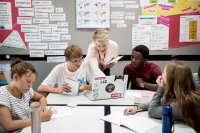Designing Engaging Assignments
Three tips for coming up with work that sparks real engagement in your students.
As I contemplated the writing assignment for our required reading of The Odyssey, I was filled with dread at the thought of reading 120 uninspired essays in which my ninth graders would dutifully recount details from the epic. Essay grading is tedious work, and I’m convinced that the hours we spend grading papers are the least effective way to positively impact students.
So I considered a framing question from the first edition of Grant Wiggins and Jay McTighe’s Understanding by Design: “To what extent does the idea, topic, or process represent a ‘big idea’ having enduring value beyond the classroom?”
I decided that the enduring value students should get from the assignment was not directly about The Odyssey at all—I wanted them to recognize how the literary archetypes we had studied in connection with the epic are found in other stories. From there, I wanted them to realize that understanding how archetypes work could help them form a deeper appreciation of the people around them.
I challenged myself with the questions: “How do I design a meaningful assignment around this big idea that engages students?” and “How do I get kids to understand the value of the work we do?”
Designing an Engaging Assignment
1. Provide choices: According to teacher and blogger Larry Ferlazzo, “Teachers in the real world recognize that although personalization has the potential to improve learning, our first job in applying any approach is to engage students in the learning process.... It’s about helping students find their spark and make their own fire.”
In order to ignite students’ interest, I asked them to identify a familiar archetype from a book, movie, or television show of their choice. They would then determine how the character breaks the archetypal mold, and write a response to analyze and explain their findings.
The students were initially skeptical and asked questions like, “So we’re just doing this to brainstorm, and then we’re writing our papers about The Odyssey, right?” I had to work to convince them that they really could write the whole paper about a story of their choosing.
The students’ ability to make their own choices generated an explosion of ideas. A few of my Harry Potter aficionados stopped in excitedly at lunch to share their insights, and there were heated discussions about the myriad ways in which Harry Potter breaks the mold of the hero archetype: “He can’t make a rational decision, so Hermione has to tell him what to do!”
A student who used to love The Magic School Bus series questioned Miss Frizzle’s role as a “teacher as a heroic figure”: “Doesn’t she actually repeatedly risk students’ lives?”
When we paid closer attention to television and films, students noticed a high school chemistry teacher who cooked meth, and how Superman, in the movie Man of Steel, was bullied as a child and felt isolated as he tried to suppress his powers.
2. Offer a challenge: Students persevere when an assignment is not only interesting, but intellectually demanding. When John Hattie lists factors that relate to student achievement, he indicates the importance of ensuring that each assignment has the optimal level of challenge—not too hard, not too easy—because “the effect size of this so-called ‘Goldilocks’ level of challenge... nearly doubles the speed of learning.”
Our study of archetypes introduced students to a concept they hadn’t before considered. They were generally able to identify a character’s archetype, but struggled to articulate the specific ways their character broke the mold.
One student was perplexed by the conflicting realities about Betty Cooper, the “good girl” from the series Riverdale. She ultimately realized that despite Betty’s good intentions, her impulsive and often careless behavior reveals that she is much more complex than her blond hair and seemingly perfect exterior lead viewers to expect.
3. Tell them why: According to best-selling author Daniel Pink, “research has shown that people do better at a task—whether that task is spelling, hitting a curveball, or playing the viola—if they know why they’re doing it in the first place. School is often all about how—here’s how you do a quadratic equation, here’s how you write a five-paragraph essay, here’s how you do a paper chromatography experiment in chemistry. The fact is, we often give short shrift to why.”
I explained to students that people, like archetypal characters, are complex. One purpose of studying archetypes is to remind us that our tendency to generalize and stereotype is often incorrect. We may think, “Oh, that person is a jock—he couldn’t possibly be good at math” or “She’s so pretty and popular—life must be so easy for her.”
Noticing how superheroes suffer with feelings of isolation and so-called good girls really aren’t so perfect after all reinforces the fact that we cheat ourselves and others when we label people based on appearances and false assumptions. My students know that we studied literary archetypes to gain a deeper understanding of why we must not judge people based on appearances.
Preparing Students for the Real World
Classroom assignments should provide students with the opportunity to make informed choices, struggle through challenging tasks, and draw their own conclusions so they can transfer these essential skills to their lives outside of school. We can foster our students’ independence in these areas by designing assignments that matter.
